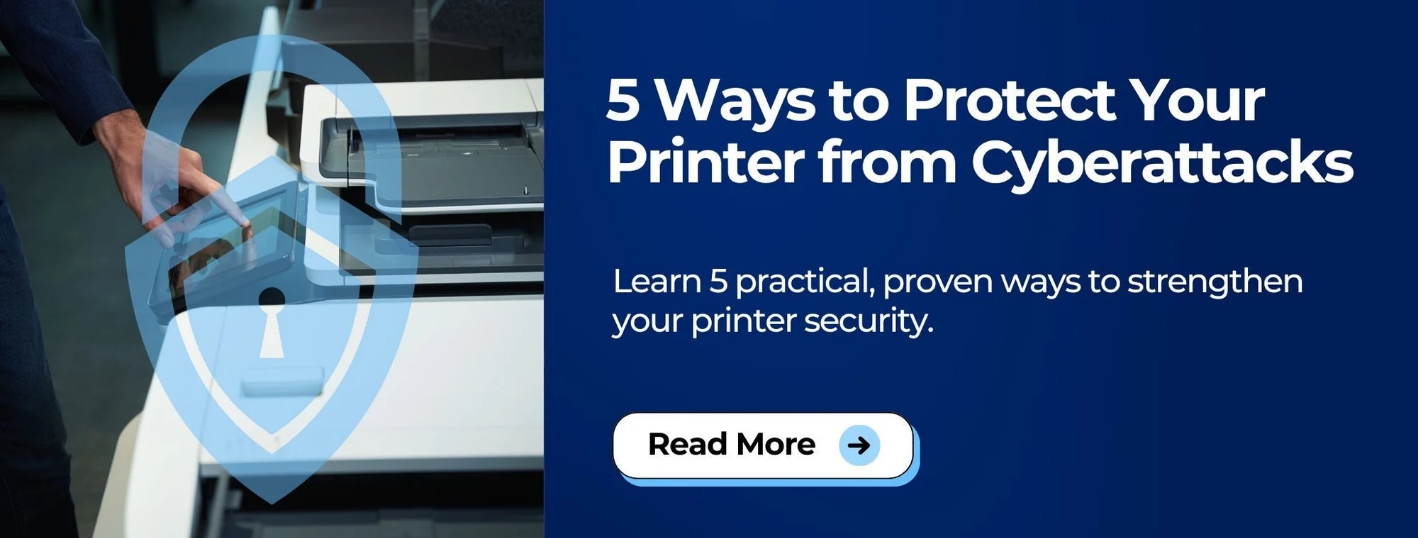
What would happen if your office network went dark tomorrow? You would have no access to files stored in cloud, no way to email clients, and no printers to push through time-sensitive documents. For too many businesses, this is a reality. In fact, nearly six in ten companies report that cybersecurity incidents caused moderate to severe disruption in the past year.
And cyber threats don’t just affect big corporations. Small and mid-sized businesses are increasingly targeted because attackers know resources are limited and defenses are often patchy. With remote work, mobile devices, and cloud platforms expanding the “attack surface,” it’s easier than ever for hackers to find an entry point.
At STPT, we’ve spent decades helping businesses secure one of the most overlooked gateways: office printers and copiers. But we also keep a pulse on the bigger cybersecurity picture. We understand that protecting your data isn’t about one device, but about your entire office ecosystem.
In this article, you’ll learn the five essential steps every office should take to strengthen cybersecurity. We’ll also cover how AI is reshaping both sides of the cybersecurity battle, why staff training matters as much as software, and the role your printers play in keeping data safe. By the end, you’ll have a clear roadmap to make your office more cybersecure in 2025 and beyond.
Table of Contents
- What Cybersecurity Means for Today’s Office
- Step 1: Use Reliable Antivirus & AI-Powered Defense
- Step 2: Back Up and Protect Your Data
- Step 3: Limit Internal Access to Sensitive Information
- Step 4: Keep Devices and Firmware Updated
- Step 5: Work With Knowledgeable IT Pros & Train Your Team
- Don’t Forget Printer Security
- Why Cybersecurity Matters More Than Ever
- Is Your Office Ready?
What Cybersecurity Means for Today’s Office
Cybersecurity encompasses more than just having antivirus software or firewalls. According to Cisco, cybersecurity is the practice of protecting systems, networks, and programs from digital attacks. A hacker doesn’t need to knock down every wall; they only need one unlocked window.
In practical terms, that means one compromised computer, one lost device, or one unsecured printer could be the open door to your entire network. Once inside, attackers can steal sensitive information, corrupt files, or even shut down operations until a ransom is paid.
According to CompTIA’s 2025 cybersecurity report, the challenge goes beyond just buying better tools. It involves building a cybersecurity culture that includes technology, workflows, and staff habits. That’s why the following five steps combine tools, processes, and people.
Step 1: Use Reliable Antivirus & AI-Powered Defense
Antivirus software is like your digital immune system. It scans for malware and eliminates threats before they spread. But the old “set it and forget it” approach isn’t enough anymore. Attackers are constantly evolving, and many now use AI themselves to create smarter, harder-to-detect attacks.
Using an advanced antivirus solution can help. Modern platforms use AI and machine learning to predict attacks, monitor user behavior, and automate responses. In CompTIA’s study, more than a third of businesses reported using AI to improve cybersecurity operations, from predicting breaches to analyzing unusual activity.
What to look for:
- Cross-platform protection (computers, mobile devices, printers).
- AI-driven threat detection to stay ahead of new malware.
- Regular updates to cover emerging vulnerabilities.
Step 2: Back Up and Protect Your Data
Imagine having to pay a ransom for access to your own data or realizing you have no backups to restore. Data loss is one of the most damaging outcomes of an attack, but it’s also one of the most preventable.
A strong backup strategy includes:
- Multiple formats: Cloud storage plus encrypted physical backups (hard drives, flash drives).
- Redundancy: Don’t rely on just one copy. Keep backups in different locations.
- Regular testing: A backup is only useful if it actually works when you need it.
CompTIA highlights that businesses are placing greater emphasis on data architecture. This involves securing data at rest, in motion, and in use. This is also critical for AI systems, since corrupted or stolen data can compromise not just security, but also decision-making.
Related Read: Moving to the Cloud: How to Get Started
Step 3: Limit Internal Access to Sensitive Information
Not every employee needs access to every file. In fact, restricting internal access is one of the simplest ways to prevent accidental leaks and intentional breaches.
The Federal Trade Commission recommends businesses follow five pillars:
- Know your information.
- Keep only what you need.
- Protect everything you keep.
- Safely dispose of unnecessary data.
- Have a response plan.
This approach ties directly into Zero Trust security: never trust, always verify. You can grant staff the access they need, but nothing more. That way, if one account is compromised, you can still contain the damage.
Step 4: Keep Devices and Firmware Updated
Devices in your office, like printers, routers, and laptops, run on firmware, the code that tells them how to operate. Firmware updates often patch security holes, so skipping them leaves your systems vulnerable.
Hackers love outdated devices because they know exactly how to exploit them. According to CompTIA, lost and outdated endpoints are among the most common causes of breaches.
Tips for staying ahead:
- Enable automatic updates whenever possible.
- Set reminders to check for firmware updates on printers, copiers, and network devices.
- Replace aging equipment that no longer receives security patches.
Upgrading device firmware is like changing the locks on a new house. Both are essential steps to ensure your security and protect your property.
Step 5: Work With Knowledgeable IT Pros & Train Your Team
Even the best tools fail if your team doesn’t know how to use them. Human error remains one of the top causes of breaches, often resulting from phishing emails, weak passwords, or accidental clicks.
CompTIA reports that 56% of companies plan to pursue cybersecurity training for their workforce. And for good reason: education is just as important as technology.
How to strengthen this step:
- Partner with experts. Smaller businesses may not need a full IT department, but they do need a trusted partner. This is where STPT helps with printer and device security.
- Train employees. Teach staff how to spot phishing, use strong passwords, and handle sensitive data.
- Keep leadership involved. Executives should prioritize cybersecurity as a business risk, not just an IT issue.
Don’t Forget Printer Security
A blind spot most businesses overlook is printers.
If you lock your front door and install security cameras, but leave the back door wide open, your house isn’t secure. Printers are that back door. They store data, connect to your network, and often process sensitive documents. If they aren’t secured, they become easy entry points.
STPT has specialized in printing for more than 35 years, and we know how vulnerable unmanaged printers can be. Here are some key steps to securing your printers:
- Use authentication for print jobs.
- Encrypt data in transit and at rest.
- Update printer firmware
For deeper insights, check out:
Why Cybersecurity Matters More Than Ever
Cybersecurity should be a concern for the entire business, not just the IT team. A single breach can cost small companies thousands in recovery, legal fees, and lost trust.
Nearly 78% of companies now rank cybersecurity as a top priority, according to CompTIA. But there’s still a disconnect between priorities and actions. While many businesses acknowledge the importance of cybersecurity, they often fail to invest enough or plan effectively.
The steps described above can help you significantly reduce your risk and protect your office’s most valuable asset: trust.
Is Your Office Ready?
Cybersecurity doesn’t have to be overwhelming. Start off small, stay consistent, and focus on covering all entry points, including printers.
Ready to strengthen your defenses? Take the next step by learning about 4 ways to protect your printers from cyberattacks.
With the right strategies and technology, you can ensure your office is cybersecure and have peace of mind.
